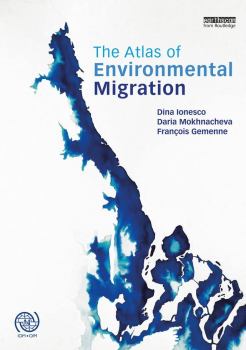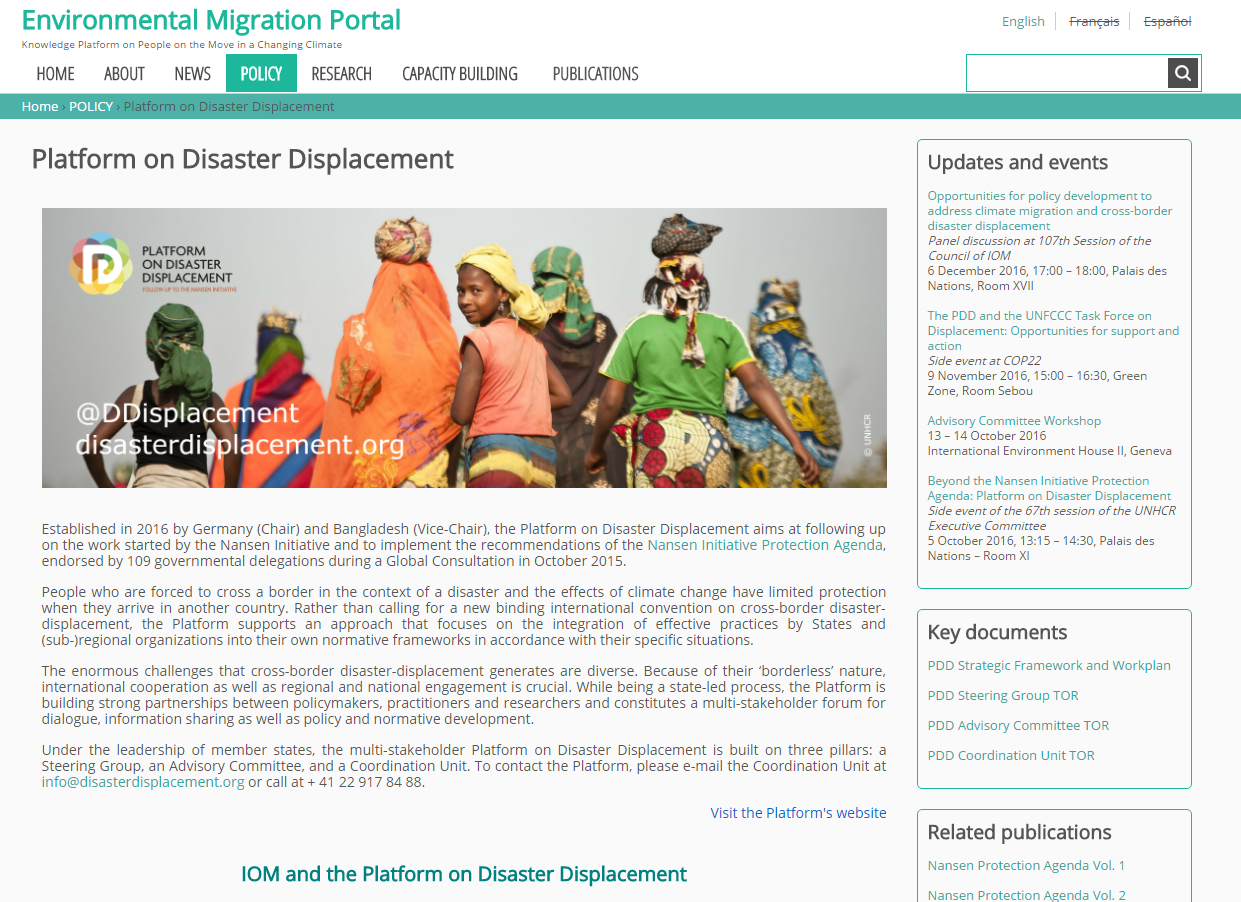Article published in OECD Development Matters on 18 January 2017
 Environmental migration is a fact. Most countries experience some form of migration associated with environmental and climate change, or forced immobility for those populations that end up trapped. Sudden-onset disasters as well as slow-onset environmental change taking place around the world, whether natural or manmade, profoundly affect migration drivers and migration patterns, even though the relationship between concrete environmental factors and migratory response is seldom direct and linear. Indeed, environmental migration or immobility results from the interplay of intricate economic, political, social and environmental dynamics, where the environmental component is sometimes hard to identify but is nonetheless critical.
Environmental migration is a fact. Most countries experience some form of migration associated with environmental and climate change, or forced immobility for those populations that end up trapped. Sudden-onset disasters as well as slow-onset environmental change taking place around the world, whether natural or manmade, profoundly affect migration drivers and migration patterns, even though the relationship between concrete environmental factors and migratory response is seldom direct and linear. Indeed, environmental migration or immobility results from the interplay of intricate economic, political, social and environmental dynamics, where the environmental component is sometimes hard to identify but is nonetheless critical.
Making sense of the debate and current evidence about environmental migration is challenging. Research on this timely topic has improved considerably, but gaps in quantitative data still exist. Currently, no financial, legal or governance frameworks specifically dedicated to environmental migration exist. Indeed, it is hard to identify environmental factors as primary drivers of migration, to quantify such population movements and to predict future environmental migration given the numerous uncertainties of climate patterns and policies. Our understanding of local-level needs, trends and impacts is limited and often focused on a few “hotspot” countries.
The Atlas of Environmental Migration[1] helps fill this knowledge gap by shining a spotlight on environmental migration. The numerous and diverse case studies featured in the analysis show that environmental migration is a multi-faceted phenomenon that takes different forms in different contexts, depending on the economic, political, development, social and environmental specificities. Policies and governmental responses play a part in determining the positive or negative outcomes for communities and individuals, shaping their vulnerability as well as their ability to stay, to migrate (inside the country or abroad) and to return. Thus, no one solution to address environmental migration exists but rather different, tailored, context-specific solutions need to be designed for each particular situation.
While migration can increase the vulnerability of individuals and communities, it can also help reduce it. More and more experts in the academic and policy fields recognise migration as a possible adaptation and risk reduction strategy to environmental stressors. Migration out of areas at risk can save lives, reduce pressure on the environment and on fragile resources, and provide households with access to alternative, more secure livelihoods. Migrants also can contribute to development and adaptation both in areas of destination and of origin. In fact, many studies demonstrate the benefits of migration for economic development in countries of destination and origin. New research and practices show that migrants can be involved effectively in climate change adaptation, environmental conservation and disaster risk reduction back home by investing their skills and remittances into such programmes.
So what is necessary to link human mobility, disaster risk reduction, climate change adaptation and development to address environmental migration?
First, evidence. The evidence needs to be improved to better inform policies and action and ensure that responses meet actual needs. More efforts should be made to strengthen local research capacity and expertise to improve data at the local level. Understanding the impacts of migration on migrants, on communities of origin and on communities of destination must be improved to better assess whether and how migration can contribute to reducing vulnerability or, on the other hand, to fuelling increased risks and precariousness. Policies need to be designed accordingly. Given climate change, demographic, economic and geopolitical trends, different factors of migration are likely to become increasingly interrelated, defying traditional interpretations and categorisations of migration and making existing migration governance systems obsolete. The key to addressing such challenges effectively is to design comprehensive responses based on thorough and reliable information and evidence.
Second, integration. Migration and social concerns should be better integrated into environmental, climate, disaster risk reduction and sustainable development policies and, conversely, environmental and climate concerns should be better acknowledged in migration policies. This could mean, for example, facilitating international seasonal labour migration to respond to seasonal climate variations through bilateral or regional agreements. It could mean recognising the potential of migrants to contribute to sustainable environmental management or climate change adaptation in their countries of origin and providing a supportive environment for the diaspora’s “green” investments, or addressing the specific needs and vulnerabilities of migrants in local/urban development plans. In other cases, this could mean improving resource management, rehabilitating degraded ecosystems, creating alternative “green” employment opportunities, and improving key public services to prevent out-migration that will allow communities to stay and migrants and displaced populations to return.
Third, collaboration. At the institutional level, responding to environmental migration requires stronger dialogue, coordination and co-operation between institutions and actors working on the environmental, sustainability and climate tracks and those working on the migration and humanitarian tracks – whether in the intergovernmental, public, academic or private sectors. In parallel, improved dialogue between research and policy communities will be essential to ensure that action meets real needs. The effectiveness of our response to existing and future challenges associated with migration and environmental change will depend entirely on our ability to effectively talk with one another, combine different areas of expertise and join forces.
Finally, balance. Efforts to promote a more balanced discourse on migration must continue. Too often, the positive aspects and benefits of migration are overlooked, and its negative effects exaggerated with migrants perceived as a threat. Coupled with improved integration measures, what’s needed is a stronger recognition of the positive aspects of migration to dispel the stereotypes about migrants and migration and to ensure a better acceptance of migrants in receiving countries and regions. At the same time, what’s equally key is supporting the many people who do not want to migrate and to leave their land, their homes and their communities through policies making it possible for them to stay.
Environmental migration is a phenomenon with complex dimensions. Whether its outcomes are positive or negative largely depends on how it is managed, and on the policies and resources that are or are not applied. The time is now not just to recognise but also to address environmental migration with constructive, effective and innovative measures that build on and go beyond traditional approaches and existing frameworks.
1) In 2016, the International Organization for Migration and Sciences Po Paris released the Atlas of Environmental Migration, a publication co-authored by Dina Ionesco (Head of the Migration, Environment and Climate Change Division at IOM), Daria Mokhnacheva, (Migration, Environment and Climate Change Specialist at IOM), and François Gemenne (Executive Director of the Politics of the Earth Programme at Sciences Po, and Senior Research Associate at the University of Liège – Hugo Observatory). A product of collaboration with numerous universities, cartographers, international agencies and experts worldwide, the Atlas of Environmental Migration is a ground-breaking publication presenting key aspects of the migration-environment nexus through more than 100 informative maps, infographics and case studies. The French version was released on 17 March 2016 (http://www.pressesdesciencespo.fr/fr/livre/?GCOI=27246100083690), and the English version of the Atlas was released on 19 October 2016 (https://www.routledge.com/The-Atlas-of-Environmental-Migration/Ionesco-Mokhnacheva-Gemenne/p/book/9781138022065).


 13 February 2017
13 February 2017



